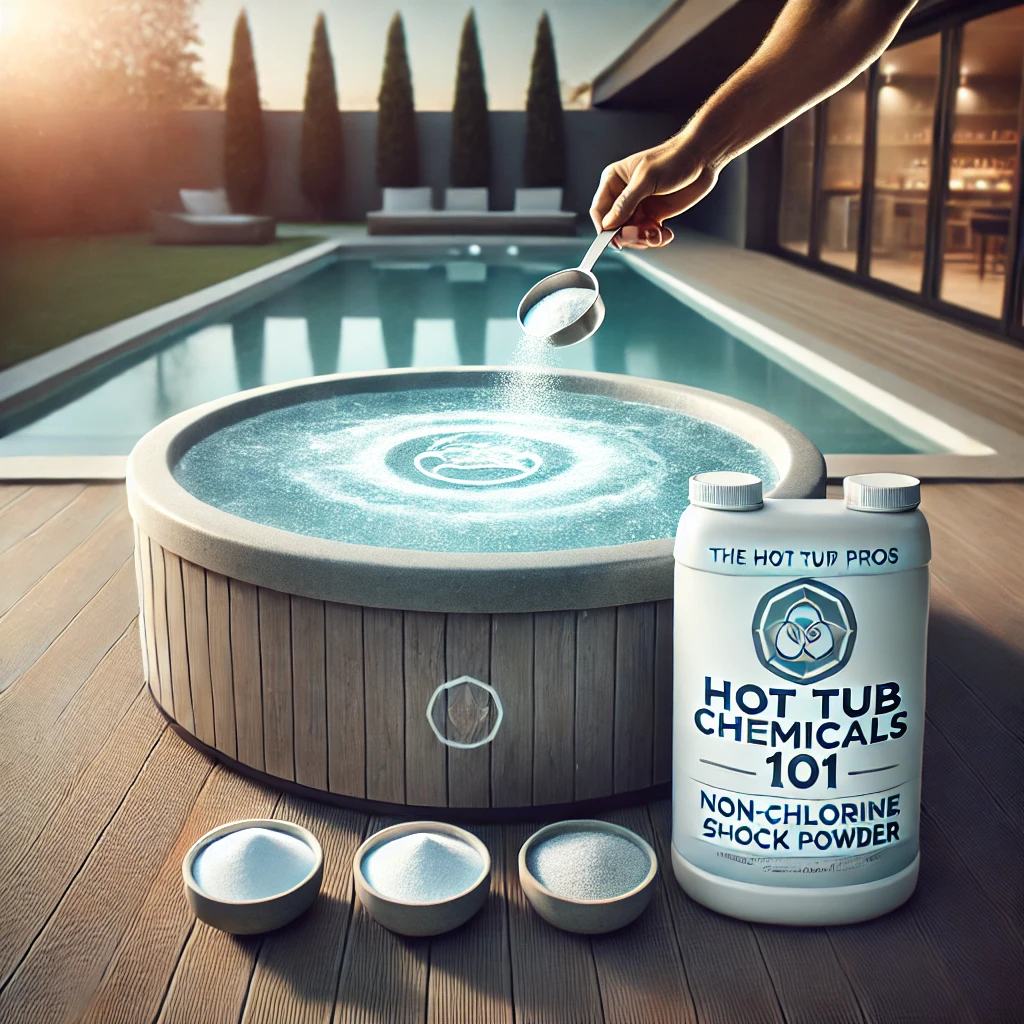
Hot Tub Chemicals 101: A Beginner’s Guide to Balanced Water
Hot Tub Chemicals 101: A Beginner’s Guide to Balanced Water
If you want consistently clean, safe, and long-lasting hot tub water, regular use of non-chlorine shock should be your number one habit. Many hot tub owners assume chlorine or bromine alone will keep their spa clean, but without regular shocking, even the best sanitizers become overwhelmed.
Every time you soak, your water collects:
- Sweat
- Body oils
- Lotion, sunscreen, or cosmetics
- Organic debris (pollen, dust, pet hair)
These contaminants bind to your sanitizer, reducing its effectiveness and causing cloudy water, odor, or irritation. That’s why shocking your hot tub should always come first.
🧼1️⃣ Sanitation: Keep Your Water Clean & Safe
What Happens When You Skip Shock?
When your sanitizer is overwhelmed, bacteria and biofilm can develop in your pipes, jets, and filters. That’s when you start noticing:
❌ Cloudy or foamy water
❌ A musty or “chlorine” smell
❌ Itchy or irritated skin
❌ Poor water clarity, even after adding chemicals
🔹 Why Non-Chlorine Shock?
Non-chlorine shock is an oxidizer that eliminates organic waste, clearing the way for your sanitizer to work more effectively—without adding extra chlorine.
✅ When to Shock Your Hot Tub
✔ Once a week (even if unused)
✔ After every soak (especially with multiple bathers)
✔ If the water looks cloudy, murky, or smells “off”
⚡ Quick Instructions: How to Use Non-Chlorine Shock
1️⃣ Remove the cover and turn on jets
2️⃣ Add 2 ounces of non-chlorine shock per 250–300 gallons
3️⃣ Run jets for 20 minutes (keep cover off)
4️⃣ Test water – if still dull or smelly, repeat the process
⚠️ Important Reminder: Dosages may vary based on product and hot tub size. Always check your chemical bottle for exact measurements
💡 Pro Tip: Keep a maintenance log or use a spa app to track chemical use—this helps you avoid overuse and optimize your routine
💬 Why You Should Shock Your Tub—Even If You Don’t Use It
We hear this question all the time:
“I haven’t used my hot tub in weeks. Do I still need to add chemicals?”
Yes! Even if your hot tub isn’t in use, water still breaks down over time due to:
- Airborne particles
- Pollen and dust
- Evaporation and chemical degradation
- Biofilm and build up
Skipping maintenance leads to *unsanitary, corrosive water*—even in an unused spa
💡 Pro Tip: If your water gets extra foamy or cloudy, consider deep cleaning your filters sooner or checking for buildup in your plumbing
🧪2️⃣ Chlorine: Maintain Safe Sanitizer Levels
Once your water is shocked and organic waste is oxidized, it’s time to make sure your chlorine sanitizer is in the proper range. This keeps the water safe to soak in and prevents bacteria from regrowing
🎯 Target Chlorine Level: 3–5 ppm (parts per million)
✅ How to Add Granular Chlorine
1️⃣ Test your water to check your chlorine level
2️⃣ If below 3 ppm, add 1 tablespoon of granular chlorine per 250–300 gallons
3️⃣ Turn on all jets and leave the cover off
4️⃣ Run for 20 minutes to circulate and release excess gases
5️⃣ Retest chlorine and repeat as needed until you reach 3–5 ppm
⚠️ Always follow the dosage instructions on your chlorine product label. Strengths vary by brand
💡 Pro Tip: Don’t overload your hot tub with chlorine just to “fix” bad water. If water remains cloudy or smells off after proper dosing, you may need to shock again or deep clean your filters
⚖️*3️⃣ Water Balance: Protect Your Hot Tub’s Equipment
Shocking your water keeps it clean, but balancing pH and alkalinity protects your hot tub’s plumbing, heater, and jet system from long-term damage
🎯 Target Levels:
✔ pH: 7.2 – 7.8
✔ Total Alkalinity: 80 – 120 ppm
✅ How to Raise pH and Alkalinity
🔹 If pH is too low:
✔ Add 1 tablespoon of pH increaser
✔ Run jets for 20 minutes
✔ Retest pH (repeat as needed)
🔹 If alkalinity is too low:
✔ Add 1 tablespoon of alkalinity increaser
✔ Run jets and retest (repeat until 80–120 ppm)
⚠️ Always follow the dosage instructions on your product label. Strengths vary by brand
💡 Pro Tip: Adjust alkalinity before pH, since alkalinity stabilizes pH movement
✅ How to Lower High pH and Alkalinity
If your water test shows pH above 7.8 and/or alkalinity over 120 ppm, it’s time to bring them down. High levels can lead to:
- Cloudy water
- Scale buildup on surfaces and heating elements
- Poor sanitizer performance
Use pH decreaser (also called pH down or sodium bisulfate) to correct both pH and alkalinity at once
✅ How to Use pH Decreaser
1️⃣ Add 1 teaspoon of pH decreaser per 250–300 gallons
2️⃣ Turn on all jets with the cover off
3️⃣ Run for 20 minutes to allow proper circulation and off-gassing
4️⃣ Retest pH and alkalinity
5️⃣ Repeat as needed until pH is between 7.2 – 7.8 and alkalinity is under 120 ppm
⚠️ Important: Go slow. Lowering too much too fast can make the water corrosive or cause pH to bounce.
⚠️ Always follow the dosage instructions on your product label. Strengths vary by brand
💡 Pro Tip: Lowering pH also brings down alkalinity. If you’re struggling to lower both, start by focusing on pH and let alkalinity follow gradually
🛠️ Let The Hot Tub Pros Handle It!
Not everyone has time to test and balance water every week. We’ve got you covered!
We offer professional hot tub service across King County, Washington, including:
✅ Quarterly cleanings
✅ Chemical balancing & filter maintenance
✅ Full-service monthly programs
✅ Hot tub troubleshooting & expert advice
📆 Book your next service today:
👉 TheHotTubPros.com
Or follow us for expert tips:
📷 @thehottubpros
